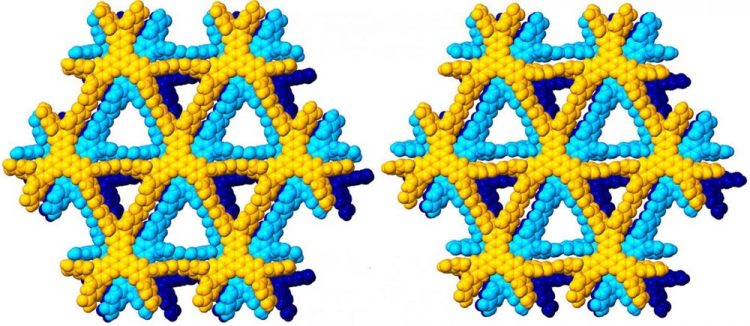Turning a porous material's color on and off with acid

Image of the created hydrogen-bonding organic framework CPHATN-(TCB) (left), and its activated version, CPHATN-1a (right). Photo credit: Hisaki I. et al., Acid Responsive Hydrogen-Bonded Organic Frameworks, Journal of the American Chemical Society, January 7, 2019.)
Chemists are working to develop porous materials made from organic molecules that have structures with well-defined openings that can separate and store gasses. Such materials can also be used in electronic devices and sensors.
In particular, researchers are investigating how to make materials using molecules bonded together by hydrogen bonds, known as hydrogen-bonding organic frameworks (HOFs). HOFs are high-crystalline, flexible, and regenerable, which make them attractive candidates. But they can also be fragile and crumble apart.
Ichiro Hisaki, a chemist at Hokkaido University's Research Institute for Electronic Science, along with Anderrazzak Douhal, a photophysicist at University of Castilla La Mancha, Spain and their colleagues developed a hexagon-shaped framework, called CPHATN-1a, and found a surprising attribute – it changes color from yellow to reddish-brown when exposed to acid solution or acid vapor.
When the acid solution or vapor is removed, either through heating or ambient evaporation, the HOF reverted back to its original yellow color.
The researchers determined that the color change is caused by protons adding onto nitrogen atoms within the compound, which shifts the spectrum of light absorbed.
Additional tests revealed that CPHATN-1a is extremely stable, maintaining its porous structure at temperatures to at least 633 Kelvin (359 C).
The robust material also stood up to heated, common organic solvents, including chloroform, ethanol and water, retaining its structure rather than dissolving or breaking apart.
“The present results would open a door to develop new porous materials with stimuli responsiveness,” the researchers note. “These could be used in the creation of new sensors or towards the visualization of minute chemical reactions.”
Media Contact
All latest news from the category: Materials Sciences
Materials management deals with the research, development, manufacturing and processing of raw and industrial materials. Key aspects here are biological and medical issues, which play an increasingly important role in this field.
innovations-report offers in-depth articles related to the development and application of materials and the structure and properties of new materials.
Newest articles

“Nanostitches” enable lighter and tougher composite materials
In research that may lead to next-generation airplanes and spacecraft, MIT engineers used carbon nanotubes to prevent cracking in multilayered composites. To save on fuel and reduce aircraft emissions, engineers…

Trash to treasure
Researchers turn metal waste into catalyst for hydrogen. Scientists have found a way to transform metal waste into a highly efficient catalyst to make hydrogen from water, a discovery that…

Real-time detection of infectious disease viruses
… by searching for molecular fingerprinting. A research team consisting of Professor Kyoung-Duck Park and Taeyoung Moon and Huitae Joo, PhD candidates, from the Department of Physics at Pohang University…





















